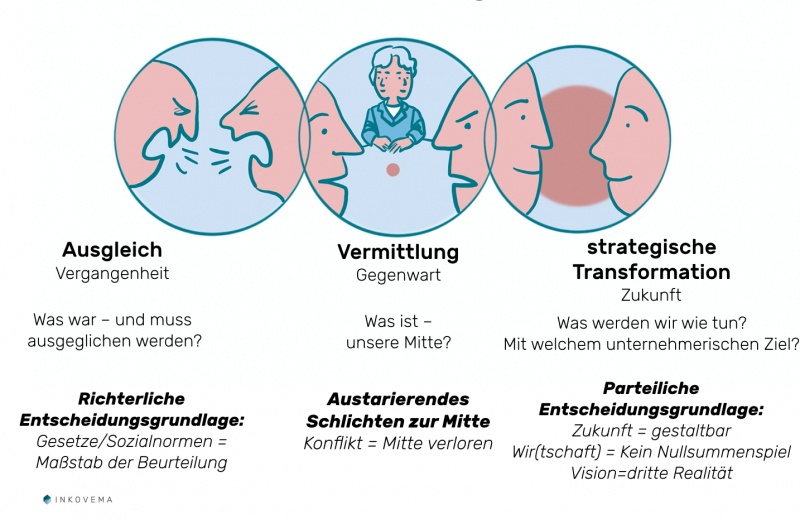Evaluative mediation
The evaluative mediation style. Localisation, description, 8 interventions and 5 risks – and it's worth it!
Introduction
The following is about the – that is rarely encountered and discussed in Germany; evaluative mediation style. This way of mediating conflicts stems from a special self-image and has specific methods that are sometimes problematic for the more traditional understanding of mediation. I will explain this in detail, the advantages and disadvantages.
After a short Localisation of the evaluative mediation style in comparison to the other mediation styles, I present this Complete and detailed show Fields of application on, his specific interventions and the Problems and risksthat go hand in hand with this.
Audio summary
1. localisation of evaluative mediation
The one There is no such thing as mediation. Rather, there are a variety of ways to mediate between conflicting parties, to support them in their efforts to reach an agreement and to find solutions to the conflicting situation together. Such mediation takes place within a certain Frame of reference The process is based on certain basic assumptions and fundamental thought patterns. Thus a each The mediator must assume that conflicts are not fated, but are caused by people and can therefore be shaped. Otherwise, mediation would be pointless. Within this mental frame of reference, however, many forms and personal styles of mediation emerge, depending on different fields of work and the different personalities of the mediators and mediants.
In principle, it is not easy to observe and study mediation styles in practice. However, the key point is that mediation styles are not fixed entities, but rather identities of a mediator based on a more or less well thought-out, professionalised approach. In contrast to judges and arbitrators, mediators have the fundamental task of Support parties in their efforts to resolve the conflict without decision-making authority and in a process-orientated mannerby structuring and moderating the (conflict) discussions, guided by certain principles.
1.2 Basic ideas of mediation
Based on the three basic ideas of mediation, temporal structures in mediation can be used to describe different mediation styles. This – perspective focussed on temporal horizons in mediation helps to understand how differently the individual styles approach their mediation task and implement it operationally. The three temporal structures – past-present-future – can be assigned to different basic ideas of conflict management and mediation.
Every mediator is guided (consciously or unconsciously) by three basic ideas when structuring mediation discussions. These three basic ideas or guiding principles are equalisation, mediation and transformation (Fig. 2).
Equalisation means that the third party ensures that perceived injustice caused by past The idea of reconciliation is to balance out the past between the parties to the conflict, be it through restorative actions (e.g. monetary payments, restitution) or through recognising requests for an apology. The idea of reconciliation brings the past of the parties involved into the mediation process, recognises the injuries suffered, calls for reconciliation and ensures appropriate conditions. In the long term, it is not worth "planting" settlements prematurely on deep-seated injuries. Successful reconciliation efforts enable the parties to the conflict to focus away from the past and onto the possibilities of the present. Thanks to the settlement, the parties can emotionally ("inwardly") let go of the hurtful past and turn their attention to the present and future, free from the burdens of the past.
Mediation means that the third party can support the conflict parties in their present mediates the conflict and explores their communicative centre. The idea of mediation reminds us that the parties "must" now make their conflict situation the subject of their communication. Only then, according to the thesis (and not at some point in the future), the open paths into the future are recognisable. Linguistically, one might think that because mediation = conciliation, this is where the core content of mediation should be located. However, this is misleading: mediation in this narrow understanding is in itself the core business of conciliation, which is why it is not surprising that conciliation and mediation are often confused. This is also the reason why it is "still" mediation when mediation is evaluative and involves concrete but not hasty proposals and why practical conciliation goes hand in hand with mediation methods.
Transformation means that mediative conflict management is also about the development and learning potential of the personalities involved. Under this banner, mediation becomes a place and a phase of learning and maturing. A relational world view that aims to transform conflict communication is predominant. The aim of the idea of transformation is not only (or not primarily) the concrete settlement of the conflict through a new material solution, but the organisation of a social learning process through constructive change in mutual conflict communication. In terms of perspective, the idea of transformation opens up the future of those involved. What will we do differently in the future? What will we have learnt when we have finished the mediation? What will change for me personally and for us together as a result of our shared experiences during the mediation? These questions are aimed less at reflecting on what has happened and more at creating the future, a change in communication patterns.

Basic ideas of mediation – and temporal structures, Sascha Weigel, INKOVEMA.
-
2. the Evaluative Mediation Style – Description.
The mediator style is evaluative when the third party (often the legal)Positions professionally evaluated and Suggestions and ideas for solutions. The assessment of what has happened and the positions in dispute is, of course, made in a respectful manner towards the persons involved and relates "to the matter". To do this, the mediator must of course have qualified expertise and often legal knowledge and have dealt with the conflict matter (beforehand!).
The evaluative style is therefore The conflict has been discussed from a legal point of view for some time. This is particularly the case in areas that are already highly legalised and where the focus is on the law, i.e. primarily in commercial matters, but also in separation mediation. Lawyers have already been involved on a regular basis. The evaluating mediators are usually lawyers themselves and the mediation discussions often resemble court-ordered settlement discussions or come close to a settlement anyway. Early Neutral Evaluationan alternative dispute resolution procedure.
The evaluative style has its origins in the Anglo-Saxon world, where it is also widespread. This probably has to do with the legal and judicial system in the respective countries, to which the Common Law is the basis. They are characterised by specific resource problems, e.g. in terms of access to the law or their closed nature, which may have led to evaluative mediation being able to grow and become the norm. The value of a non-binding opinion from a neutral third party ultimately stands and falls with the authority and credibility of this person. However, if other avenues of neutral evaluation are (almost) closed, it is more likely that this approach will become established.
In Germany, however, this model of mediation has - as far as can be seen - not become established.
2.1 Evaluative mediation style – attitude and intentions.
The (evaluating) mediator should also have a Benevolent and appreciative attitude towards the parties to the conflict. His intention is to preserve and promote the conflict parties' own responsibility (autonomy, self-responsibility) during the mediation and in particular with his assessments. The third party evaluates the situation, the behaviour, but never the conflict parties as such – and certainly not in a negative way. This technical assessment usually concerns the legal framework (is the disputed position legally tenable?), but this is not mandatory. An evaluation of economic or even ethical or scientific issues/framework conditions is just as conceivable.
Examples: The parties related under company law, business partners, argue about the investment risk and the significance of their own balance sheets and only secondarily about the legality of the procedure. Or the parties argue about the question of whether and how they should continue research in an - ethically problematic - direction and who they should inform or ask for permission, and how the data and results to date should be interpreted? Similar disputes can arise in large-scale construction projects. In all of these cases, it is sometimes worth seeking the advice of a professionally qualified mediator to whom the conflict is presented in a mediation setting, i.e. in which the third party assumes sovereignty over the process.
All of these functional framework conditions can be questions that can be put to a mediator in conflicts. If the mediator contract has established the mediator's duty to mediate in an evaluative manner, the parties may assume that the mediator will also comment on the matter. Such an evaluation and assessment by the neutral mediator offers the parties to the conflict Aspects of the decision-making basis to be developed jointly to resolve the conflict. For this reason alone, the evaluating mediator acts as a mediator. evaluative, not judgemental. The evaluating mediator's intention is basically to Mediation as an opportunity to resolve the dispute professionally and to everyone's satisfaction in order to enable their (working) relationship to continue to run smoothly.

2.2. Evaluative mediation style – Selected interventions in practice
Typical interventions of evaluative mediation work are presented below - admittedly not exhaustively.
1) Intervention: clarification of order
The most important and significant intervention is at the beginning of mediation: the Clear and comprehensible order clarification on all sides. The evaluating mediator should have clearly agreed with the parties involved whether and to what extent their evaluations, assessments, judgements and suggestions are generally desired and welcome or not. This form of Order clarification offers the best precaution, that the fears and concerns regarding an evaluative style can be resolved and the risks regarding the principles of mediation (personal responsibility, neutrality, etc.) are minimised.
1) Intervention: rules of conversation and behaviour
In practice, the evaluative style is often characterised by the fact that it can Direct rules of conversation and behaviour and leaves the conflict parties little room for manoeuvre. This depends on the mediator's relevant experience. The motto here could therefore be: "This is how it works here with me - if you want my assessment as a result of a comprehensive familiarisation!". This intervention is also in the service of the solution-orientation of this style.
3) Intervention: Professional, not personal judgement
Evaluative mediation style also means that during the mediation discussions, the mediator evaluates the points of view and positions of the parties. professionally assessed, so the agreed reference standard, measures and analyses its assessment. The mediator will point out argumentative weaknesses, e.g. inform about conflicting case law or communicate physical or legal limits during construction or similar. However, these assessments and judgements are only used by the parties to the conflict to make decisions, not as a requirement to follow them. This is an essential difference that is far too rarely recognised.
4) Intervention: Submit ideas for solutions
The evaluating mediator becomes active in "communicative stalemate situations" and in the search for solutions in general Submitting suggestions and ideas. It is also conceivable that he Suggested corrections to the chain of reasoning submitted. There is a lot of room for manoeuvre here because the mediator's entire professional expertise (especially with regard to his basic profession!) should be used.
5) Intervention: Prior knowledge
The above interventions make it clear that the evaluating mediator Familiarise yourself with the subject matter of the dispute before the mediation sessions begin must. If necessary, he will Request (copies of) files or detailed Request statements. This is a typical intervention in order to fulfil the evaluation mandate and is in stark contrast to other styles of mediation, which tend to take care not to take note of anything or anyone before starting.
6) Intervention: individual interviews
In order to carry out the task of critical appraisal and direct feedback constructively in the tense situation of a conflict, it is worthwhile for evaluating mediators to methodically focus on the Shuttle Diplomacy (Caucus Mediation) to fall back on, i.e. alternate between individual conversations. This prevents loss of face and enables a lasting change of perspective for the conflict parties.
7) Intervention: Directives
Evaluating mediators sometimes express the following opinions directly about what needs to be done. Such an "extreme-evaluative style" is also known as directive mediation style labelled. Such a Arrange may, however, regularly be limited to restricting the parties' room for manoeuvre in negotiations by excluding certain points of contention (issues) and specifically naming the room for manoeuvre in negotiations. The independent solution is then to be sought within this room for manoeuvre, e.g. because these are the areas that the mediator believes (as a result of the previous discussions) hold the solution, if any. It is therefore more a question of opening up room for manoeuvre than of giving precise instructions for action.
8) Intervention: BATNA + WATNA
A particularly helpful intervention is the (home) task, specifically to clarify the BATNA and the WATNA. These are generally two important preparations for negotiations that are often omitted and make negotiations more difficult. The Best Alternative To Negotiated Aggreement and the Worst Alternative To Negotiated Aggreement help the parties to keep a clear head during negotiations. To do this, however, they must have been consciously worked out and defined. The key questions are: What will you do at best/at worst afterwards if you do not reach an agreement?
2.3 Evaluative mediation style – problems and risks.
An evaluative approach harbours certain risks for all parties involved. Mediators and mediants should be aware of this and agree on it in the course of clarifying the mandate. This working alliance is also a contract and clarifies how the parties want to get along in and through the mediation (so that they do not make mistakes). This clarification work serves the interests of both the mediator and the mediants and should not be underestimated (contract work). The following risks and problems are relevant to evaluative mediation:
1) Neutrality principle?!
Evaluations are not unproblematic with regard to the Principle of neutrality. Mediators must act "neutrally" in accordance with Section 1 (2) MediationsG. Neutrality here means procedural to be interpreted. The mediator is obliged to treat the parties equally throughout the mediation process. Evaluations in the conflict matter can be to the detriment of one of the parties involved or at least be perceived as unfair and not neutral. Whether this is justified from an objective point of view or not is irrelevant. This is because if one of the parties does not regard the mediator as neutral experiencedhe will question and terminate the mediation. The idea of the evaluating mediator is generally that the parties to the conflict can take a critical look at their arguments. However, once suspected of being biased, any further mediation with the suspected mediator will be seriously jeopardised. The evaluating mediator must remain aware of this risk. But the risk can be managed and is worth it.
2) Principle of personal responsibility?!
Assessments by the mediator can also be made with regard to the Principle of personal responsibility pursuant to § 1 para. 2 MediationG appear problematic. The parties strive for their own response to the conflict situation, which is why opinions and assessments by third parties can be obstructive, distracting or have a negative influence. Evaluations, especially in the form of suggestions, are also more a matter of Arbitrator, less of mediators. However, as already mentioned, this is the core element of mediation: and this is where the tasks of mediators and conciliators are actually similar. And evaluating mediators actually influence conflict resolution in terms of content, which is in line with their mandate and part of their contractual obligation - insofar as this has been agreed. Evaluations by third parties then form the The basis of the conflicting parties' decision, but not a requirement. Such evaluations can encourage the parties to think further and deeper, to adapt and then clarify the points in dispute. This is not an unmediated restriction, but a realisation of personal responsibility true to the motto: only they can do it, but they don't have to do it alone. That is - I would like to think - the core idea of mediation.
3) Authorisation to give legal advice?!
Evaluative mediation combines the Legal advice with mediation. This is with regard to the Legal Advice Act problematic. However, regardless of the fact that there must be a corresponding authorisation to provide legal advice, which does not include training and working as a mediator, it must be noted that a legal assessment of the situation does not necessarily constitute legal advice. It usually lacks the strategic element that is typical and constitutive of legal advice from a lawyer. Providing information on the basis of decisions and legal commentaries does not constitute legal advice. However, since in practice this is often a Balancing act between counselling and information the danger is particularly virulent for non-lawyer mediators. Mediators who are also authorised to provide legal advice, i.e. mainly lawyer-mediators, on the other hand, do not have to take this balancing act into account, but merely have to ensure that their mediating counselling is desired, required and helpful.
4) Finalisation fixation?!
The evaluative style of mediation is sometimes suspected, too conclusion-orientated to be. As already mentioned, supporters in particular see mediation as an opportunity to resolve the conflict - and ultimately also define it by the the final agreement ending the conflict will ensure the success of the Mediation. The fact that mediation can also be successful if the parties involved do not sign a final agreement may be lost. In internal mediation in particular, the communicative aspect of the mediation process is often seen as meaningful and valuable, which is of significance far beyond the current and "unresolved" conflict. In these cases, the transformative value of mediation are misjudged and not sufficiently recognised by conclusion-oriented evaluators. Representatives of the evaluative style should pay attention to this and be open to such successes of mediation. The final settlement (one of the basic ideas of mediation, see above) represents a parallel for mediation to the judicial handling of conflicts, but is not the only value and basic idea of mediation: While the idea of mediation is also implemented in conciliation, the idea of transformation is specific to mediation, even if it is not emphasised in evaluative practice.
5) Arbitration similarities?!
Evaluative mediation is sometimes similar to the ADR instrument of Early Neutral Evaluation. This is a "Special form of arbitration"in which the neutral third party is involved at the earliest possible stage of the conflict in order to carry out a neutral evaluation. Whereas in an early neutral evaluation it is not uncommon for a retired judge to carry out a summary legal assessment, in an evaluative mediation at least a trained mediator acts, whose stylistic focus is on mediating the disputed positions rather than transforming the parties to the conflict. Legal problems do not arise as a result of this factual proximity between the two procedures. However, in the Practice of conflict management systems and the associated Development of a variety of conflict management procedures care must be taken to ensure that the corresponding mediation procedures are not carried out in a purely evaluative manner so as not to render the instrument of early neutral evaluation superfluous, insofar as it is provided for. This would be a waste of resources, even if it is permitted.





Leave A Comment